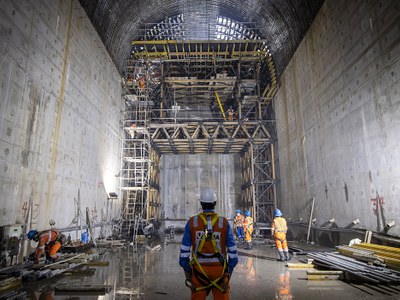ULMA involved in the construction of a core structure in Peru’s San Gabán III Hydroelectric Project
One of the project’s key elements is the Air Cushion Surge Chamber, designed to stabilize the system’s hydraulic pressure. Built by China International Water & Electric Corp (CWE), this reinforced concrete structure—spanning over 9 kilometres—regulates the water pressure flowing from the headrace tunnel. The design accounts for a hydraulic phenomenon similar to water hammer: high-speed water enters the chamber, rises until a specific volume is reached, and then generates a return push. This effect dissipates energy, reduces pressure, and enables the vertical drop of the flow to the next hydroelectric stage.
The chamber measures 92.40 metres in length and 18.50 metres in height, from the base level to the vault crown, with walls 1.10 meters thick. Its construction was divided into two phases: first, 70 cm of concrete was poured with an embedded steel insert along the entire perimeter of the section; then, the remaining 40 cm was completed to reach the full wall thickness.
Tunnel Geometry:
| Parámetro | Unidades | |
| Side Wall | Thickness | 1.10 m |
| Height | 11.60 m | |
| Vault | Slab thickness | 1.10 m built in two phases:
|
| Inner radius | 5.70 m (fase 02) | |
| Outer radius | 6.10 m (fase 02) |
For the second phase of the chamber slab construction, ULMA supplied an MK Tunnel Formwork Carriage, a formwork system specifically designed for large-scale civil engineering projects. This equipment, weighing approximately 60 tons, includes dual wheel axles, access ways, working platforms, and safety handrails, enabling efficient casting of 40 cm thick slabs in 6-meter sections.
The MK Formwork Carriage for tunnels is a lightweight, mobile system that integrates both support and formwork into a single structure, optimizing concreting operations in tunnels, underground stations, connections, and hydraulic galleries. Its cost-efficiency lies in the use of reusable standard components, reducing both costs and logistical complexity. Its simple, modular design supports fast work cycles, easy handling, and repositioning without dismantling.
The system stands out for its versatility, adapting to various geometries, loads, and pressure conditions. It features 6 mm steel panels for high-quality finishes and allows for independent pouring of vaults and walls. The adjustable spacing between segments enhances load-bearing capacity. Additionally, the carriage includes inspection windows, nozzles, and vibrator supports, with manual or hydraulic propulsion depending on site needs. In this project, 24 vibrators arranged in three rows were used for concrete compaction. The carriage was moved using two capstans, each with a pulling capacity of 3,200 kg.
With integrated platforms and access systems ensuring work-at-height safety, the MK Carriage delivers a comprehensive solution combining economy, adaptability, and safety in tunnel construction.
The construction process using the MK Tunnel Carriage followed a steady pace, with 48-hour cycles per section. After each concrete pour, the front cover were removed after 12 hours, a process that took 3 to 4 hours. 24 hours post-concreting, the system was lowered using sixteen 20-ton hydraulic jacks, the inner formwork was removed, and the carriage was repositioned—an operation completed in 3 to 5 hours. The front formwork was then reinstalled, and the next pour began.
The project progressed according to schedule, with all phases delivered within the expected time frame and in compliance with quality and safety standards.


